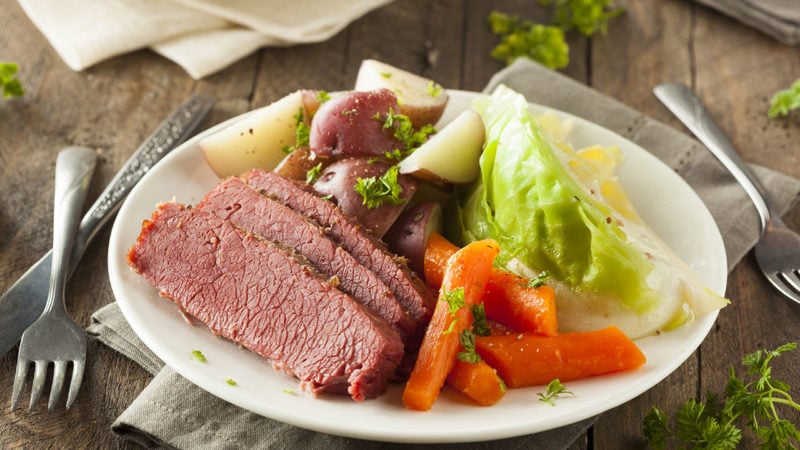Last Updated on August 26, 2022
You may have outgrown green beer, but it’s still fun to pull together a St. Patrick’s Day celebration in honor of Irish culture and heritage.
Soda bread, lamb stew, seafood pie, colcannon are all good places to start, but without corned beef and cabbage, are you really doing St. Patrick’s Day right?
As the one dish that’s most commonly associated with St. Patrick’s Day, corned beef and cabbage might seem central to the old-fashioned (and under-seasoned) repertoire of Irish-American grandmas, but it’s actually part of a culinary tradition of boiled beef dinners all over the world. French pot au feu, Italian bollito misto, Austrian tafelspitz, and Vietnamese pho bo are just some cultural variations on the boiled dinner—a meal that has gradually become synonymous with Irish-American cooking over the course of the 20th century.
New England boiled dinner—brisket (sometimes, but not always, preserved with a brining process also called corning) boiled with root vegetables and cabbage is about as sturdy a staple meal as you can get. And it might be the original one-pot meal, with recipes dating back to the earliest days in colonial New England. Traditional versions call for dry-brined brisket, simmering for up to 3 hours. Vegetables are added in stages, with onions going in first, followed by potatoes and carrots, and quartered cabbage sliding into the pot at the end.
In The Yankee Cookbook, published in 1939, author Imogene Wolcott writes that in New England “‘boil dinners’ were always served once a week from early fall until late spring. Monday and Wednesday were favored days.” In a traditional boiled dinner, beets were often cooked separately and served alongside—with the leftover beef and beets reserved for red flannel hash for the next day’s breakfast. And a Vermont version, according to James Beard in his 1972 book, American Cookery, was studded with cloves, rubbed with maple syrup and glazed in a hot oven before serving.
When early Irish-American immigrants to the U.S. transformed St. Patrick’s Day from a religious celebration to a cultural one, their own culinary tradition of eating bacon and cabbage shifted to the corned beef brisket that was already popular in their new country, according to Smithsonian Magazine.
So if you’re planning a St. Patrick’s feast, put corned beef and cabbage on the menu. But maybe take a nod from other cultures, as early Irish immigrants did, and flip the script with your dish. Add a chicken and some sausages to the pot, maybe some beef bones to enrich the broth. Cook the vegetables separately in well-salted water, and try the ruffly Savoy cabbage instead of the standard green globes.
Finally, don’t forget the condiments. Spicy mustard and horseradish are traditional accompaniments to boiled dinner; for Italian bollito misto, the perky salsa verde included below, and mellow salsa rossa are invariable partners to the meat. But you could serve all of them.
And bonus—all types of boiled dinner go well with Guinness.
Salsa Verde
Makes 4 to 6 servings
Adapted from Essentials of Classic Italian Cooking, by Marcella Hazan
Ingredients
⅔ cup parsley leaves
6 anchovy filets
2 tablespoons capers, plus more to taste
1 garlic clove, chopped fine
1 teaspoon red wine vinegar
½ cup extra virgin olive oil
Salt, to taste
Directions
- Combine all ingredients in a food processor or blender and blend until combined. Leave the texture slightly chunky, and taste and adjust the seasoning.
Leigh Belanger is a writer, editor, and culinary expert with a passion for food, storytelling, and sustainability. As an Editorial Director for ButcherBox, she has crafted engaging content that highlights high-quality ingredients, delicious recipes, and the joy of home cooking. Through her work, Leigh inspires people to cook thoughtfully and creatively.



